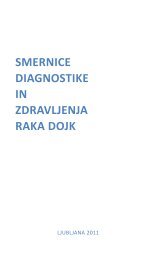You also want an ePaper? Increase the reach of your titles
YUMPU automatically turns print PDFs into web optimized ePapers that Google loves.
CD44 and CD155 expression on human glioma in vitro: a flow<br />
cytometric, immunocytochemical and TIRF microscopy study <strong>of</strong><br />
invasion indicators<br />
M. Navarros Rego, N. Karatas, G. Whitaker, P. B. Nunn, P. Warren, G. J. Pilkington<br />
Cellular & Molecular Neuro-oncology Group, Institute <strong>of</strong> Biomedical & Biomolecular Sciences, School<br />
<strong>of</strong> Pharmacy & Biomedical Sciences, University <strong>of</strong> Portsmouth, White Swan Road Portsmouth PO1 2DT,<br />
UK<br />
The poliovirus receptor, CD155 (PVR) is expressed on neoplastic glia and has already<br />
been used in therapeutic targeting <strong>of</strong> glioma. Recently CD155 has been proposed as<br />
playing a key role in glioma motility and invasion. CD44 is a cell adhesion molecule,<br />
originally described as the lymphocyte homing receptor, which is has two is<strong>of</strong>orms with<br />
respective molecular weights <strong>of</strong> 80-90kDa and 150kDa. The lower molecular weight<br />
is<strong>of</strong>orm mediates attachment to hyaluronic acid (HA), which is present in relatively<br />
high concentration within the brain. CD44 is over-expressed in CNS and mediates both<br />
mediates glioma cell adhesion and invasion. Moreover, CD155 resides proximal to CD44<br />
on the cell membrane <strong>of</strong> monocytes. The interactive role <strong>of</strong> the two molecules, CD44 and<br />
CD155, therefore merits investigation in the context <strong>of</strong> brain tumour invasiveness. Our<br />
aims were, therefore, to evaluate the expression levels <strong>of</strong>, and spacial relationship between,<br />
CD44 and CD155 in cultured glioma at high and low passage.<br />
High and low passage in vitro cultures <strong>of</strong> glioma were immunocytochemically stained using<br />
CD44 and CD155 antibodies and imaged by epi-fluorescence. Quantitative analysis was<br />
obtained by flow cytometry and the special relationship between the two epitopes on the<br />
cell surface was elucidated by total internal reflected fluorescence (TIRF) microscopy.<br />
Immunocytochemistry showed both CD44 and CD155 to be expressed at high and low<br />
passage numbers <strong>of</strong> glioblastoma in vitro. Double staining revealed both antigens to be<br />
expressed on the cell membrane at close but distinct sites. Flow cytometry revealed a<br />
higher expression level <strong>of</strong> CD44 compared with CD155 on all cultures tested.<br />
Having shown that these two molecules are co-expressed and are closely apposed on the<br />
cell membranes <strong>of</strong> glioma cells and are both involved in migration and invasion will are<br />
now aiming to carry out live cell imaging and Transwell Boyden chamber assays. In these<br />
experiments the influence <strong>of</strong> monoclonal antibody blocking and siRNA knock-down for<br />
both molecules, singularly and together will be used to establish any synergy or additive<br />
effect <strong>of</strong> CD44 and CD155 on glioma invasion.<br />
Acknowledgements: M Navarros Rego was supported by a Leonardo da Vinci Scholarship.<br />
p37119
















